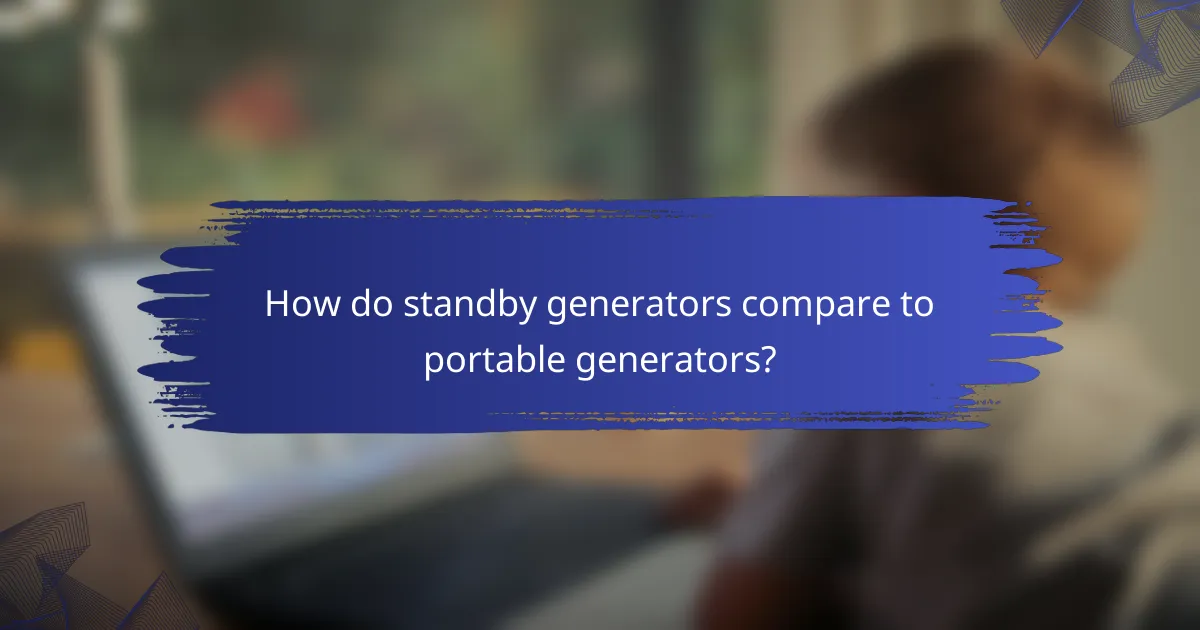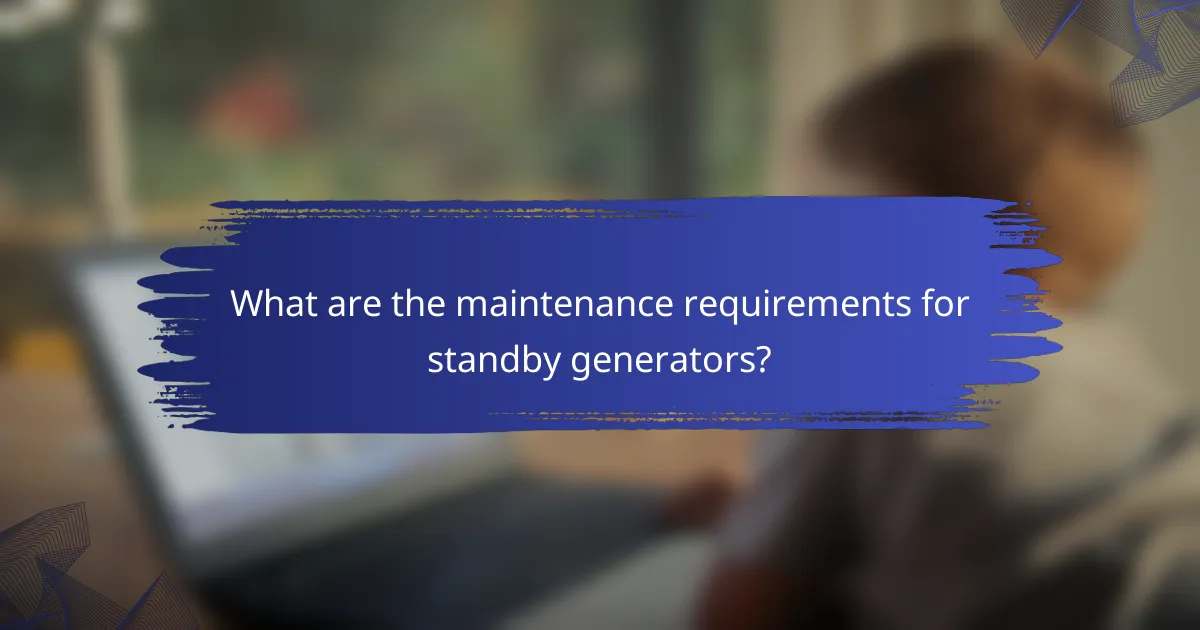Standby generators are a vital asset for both homeowners and businesses, providing reliable power during outages and enhancing property value. Evaluating the return on investment (ROI) involves analyzing installation costs, potential energy savings, and maintenance expenses to determine if the initial expenditure is warranted by long-term benefits. Understanding the factors influencing generator costs, such as size and fuel type, is essential for making informed investment decisions in backup power solutions.

What are the benefits of standby generators in urban areas?
Standby generators provide essential benefits in urban areas, primarily by ensuring reliable power during outages, increasing property value, and enhancing safety and security. These advantages make them a practical investment for homeowners and businesses alike.
Reliable power during outages
Standby generators automatically activate during power outages, providing immediate electricity to homes and businesses. This reliability is crucial in urban settings where outages can disrupt daily life and operations.
Most standby generators can power essential appliances such as refrigerators, heating systems, and medical equipment, ensuring that residents remain comfortable and safe. Depending on the generator’s capacity, it can support a range of devices, from critical loads to entire homes.
Increased property value
Installing a standby generator can significantly enhance property value in urban areas. Homes equipped with generators are often more appealing to buyers, particularly in regions prone to frequent power outages.
According to real estate experts, properties with backup power solutions can see an increase in value by a percentage that varies based on local market conditions. This investment not only provides immediate benefits but also contributes to long-term financial returns.
Enhanced safety and security
Standby generators improve safety and security by ensuring that security systems, lighting, and emergency services remain operational during outages. This is particularly important in urban environments where safety concerns can be heightened during power failures.
By maintaining power to security cameras and alarms, homeowners can deter potential intruders and protect their property. Additionally, reliable lighting during outages can prevent accidents and enhance overall safety for residents and visitors alike.

How to evaluate the return on investment for standby generators?
Evaluating the return on investment (ROI) for standby generators involves analyzing installation costs, potential savings on energy bills, and ongoing maintenance expenses. This assessment helps determine if the upfront investment is justified by long-term benefits.
Calculate installation costs
Installation costs for standby generators can vary significantly based on the generator’s size, type, and the complexity of the installation. Typical expenses range from a few thousand to over ten thousand USD, depending on local labor rates and any necessary permits.
When calculating installation costs, consider additional expenses such as electrical upgrades, fuel supply lines, and transfer switches. Obtaining multiple quotes from licensed contractors can provide a clearer picture of potential costs.
Assess potential savings on energy bills
Standby generators can lead to savings on energy bills, especially during peak demand periods when utility rates are higher. By providing backup power during outages, they can prevent losses associated with spoiled food, disrupted business operations, or costly repairs.
To estimate savings, analyze your average monthly energy usage and consider how often outages occur in your area. In regions with frequent power interruptions, the potential savings can be substantial, potentially offsetting installation costs over time.
Consider maintenance expenses
Maintenance expenses for standby generators include routine servicing, repairs, and replacement parts. Regular maintenance is crucial to ensure reliability and efficiency, typically costing several hundred dollars annually.
It’s essential to factor in these ongoing costs when evaluating ROI. Neglecting maintenance can lead to larger, more expensive repairs and reduced lifespan of the generator, ultimately impacting your overall investment. Consider setting aside a maintenance budget as part of your financial planning.

What factors influence the cost of standby generators?
The cost of standby generators is influenced by several key factors, including generator size, fuel type, and installation complexity. Understanding these elements can help you make informed decisions about your investment in backup power solutions.
Generator size and capacity
The size and capacity of a standby generator directly affect its cost. Larger generators that can power more appliances or entire homes typically come with a higher price tag. It’s essential to assess your power needs to choose a generator that balances capacity and cost effectively.
For residential use, generators range from around 5 kW to 20 kW. A generator on the lower end of this range may suffice for essential appliances, while larger units are necessary for whole-house power. Consider future expansion needs when selecting the size.
Fuel type and efficiency
The type of fuel a generator uses significantly impacts both its initial cost and ongoing operating expenses. Common fuel types include gasoline, propane, and natural gas, each with different price points and availability. Generally, natural gas tends to be more cost-effective for long-term use.
Efficiency ratings also play a role in overall costs. Generators with higher efficiency may have a higher upfront cost but can save money in fuel expenses over time. Evaluate local fuel prices and availability to determine the best option for your situation.
Installation complexity
Installation complexity can vary widely based on the generator’s size, the location of installation, and local regulations. More complex installations, such as those requiring extensive electrical work or permits, will increase overall costs. It’s advisable to consult with a licensed electrician to understand the specific requirements for your area.
In some cases, additional features like automatic transfer switches or soundproof enclosures may add to installation costs but can enhance functionality and convenience. Always factor in these potential expenses when budgeting for a standby generator.

How do standby generators compare to portable generators?
Standby generators are permanently installed systems that automatically provide power during outages, while portable generators are movable units that require manual setup. The choice between the two depends on power needs, budget, and installation preferences.
Power output differences
Standby generators typically offer higher power output compared to portable generators, making them suitable for powering entire homes or large appliances. While portable generators usually range from 1,000 to 8,000 watts, standby units can deliver anywhere from 5,000 to 20,000 watts or more, depending on the model.
This difference in output means that standby generators can support essential systems like heating, cooling, and refrigeration simultaneously, whereas portable generators may require careful management of loads to avoid overloading.
Cost analysis
When evaluating costs, standby generators generally have a higher upfront price, often ranging from a few thousand to over ten thousand USD, including installation. In contrast, portable generators can be purchased for several hundred to a couple of thousand USD, making them more accessible for those with tighter budgets.
However, it’s important to consider long-term costs, such as fuel consumption and maintenance. Standby generators are usually more fuel-efficient and require less frequent refueling than portable options, which can lead to savings over time.
Installation requirements
Installing a standby generator usually involves professional installation, including electrical and plumbing work, which can add to the overall cost. These systems must comply with local building codes and often require permits, making the installation process more complex.
In contrast, portable generators are easier to set up and can be used right out of the box, requiring only a proper outdoor location and extension cords. However, users must ensure they follow safety guidelines to prevent carbon monoxide poisoning and other hazards.

What are the maintenance requirements for standby generators?
Standby generators require regular maintenance to ensure reliability and longevity. Key maintenance tasks include routine inspections and battery upkeep, which are essential for optimal performance during power outages.
Regular inspections
Regular inspections are crucial for identifying potential issues before they escalate. Typically, these inspections should occur every six months or after significant usage, focusing on components like the engine, fuel system, and electrical connections.
During an inspection, check for signs of wear, leaks, and corrosion. Keeping a maintenance log can help track performance and any repairs needed, ensuring that the generator remains in good working condition.
Battery maintenance
Battery maintenance is vital for standby generators, as a fully charged battery is necessary for reliable startup. Inspect the battery at least every three months, ensuring that connections are clean and tight, and that the fluid levels are adequate.
Consider replacing the battery every three to five years, depending on usage and environmental conditions. Using a trickle charger can help maintain battery health, especially in regions with extreme temperatures.










